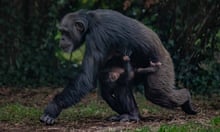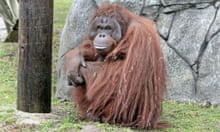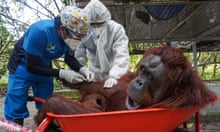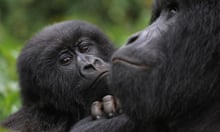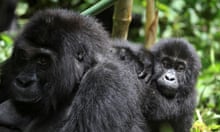It is one of the most recognisable animals in the world and one of the most endangered, but a new census reveals the surviving mountain gorilla population has now risen above 1,000.
This represents a rise of 25% since 2010 in its heartland of the Virunga Massif in central Africa. It also marks success for intensive conservation work in a region riven by armed conflict, and where six park guards were murdered in April.
Sir David Attenborough, whose 1979 encounter with the great apes remains a famous television moment, said: “When I first visited the mountain gorillas, the situation was dire: the number of these remarkable animals was dreadfully small. It is incredibly heartening therefore to see how the efforts of so many different groups – communities, governments, NGOs – have paid off.”
But Attenborough, an ambassador for WWF UK, warned: “The threats to mountain gorillas haven’t disappeared entirely, of course, so now the challenge must be to ensure that these achievements are sustained long into the future.”
The 1979 encounter led him to reflect: “There is more meaning and mutual understanding in exchanging a glance with a gorilla than any other animal I know – they are so like us.”
The new survey involved 12 teams covering more than 2,000km of difficult, forested terrain on the borders of the Democratic Republic of Congo, Uganda and Rwanda. They searched for signs of the animals, such as nest sites, and collected faecal samples for genetic analysis.
The survey found the Virunga population has risen to 604, in 41 social groups, compared to the 480 individuals counted in the last survey in 2010. The only other place mountain gorillas survive is in Uganda’s Bwindi Impenetrable national park, where the last census in 2012 recorded more than 400 animals.
The rise in numbers follows the introduction of park guards, veterinary care, community support projects and regulated tourism. However, the survey found that direct threats from wire or rope snares persist. These are set by people to catch antelopes for food, but can kill or harm gorillas.

The survey teams destroyed more than 380 snares and discovered one containing a dead mountain gorilla. Other new threats loom large on the horizon, according to WWF, including climate change and further habitat destruction for development.
Alison Mollon, from Fauna & Flora International, said the mountain gorilla was on the very precipice of extinction in the 1970s: “[But] we need to remain extremely vigilant, particularly for the threat posed by the transmission of human-borne diseases that are relatively innocuous for us but potentially fatal to other primates.”
In April, five rangers and a driver were killed in an ambush in Virunga national park in the Democratic Republic of the Congo. The loss of life was the worst in the history of the national park, where more than 170 rangers have died protecting animals over the last 20 years.
Also in April, another major survey revealed there are far more western lowland gorillas than was previously thought, as many as double earlier estimates. The western lowland gorilla, which accounts for 99% of all living gorillas, is now thought to number around 360,000 animals. But these populations have fallen 20% in just eight years due to threats the researchers summarise as “guns, germs and [felled] trees”.



